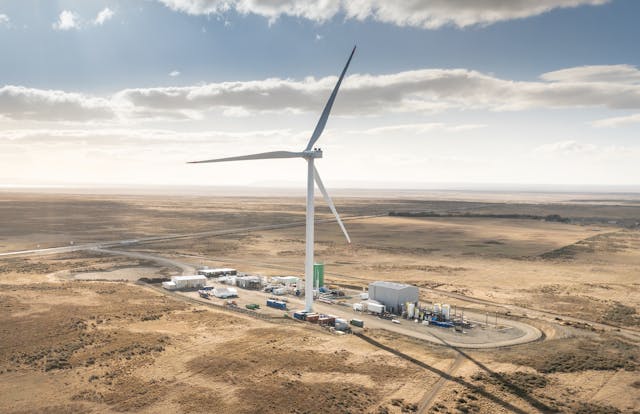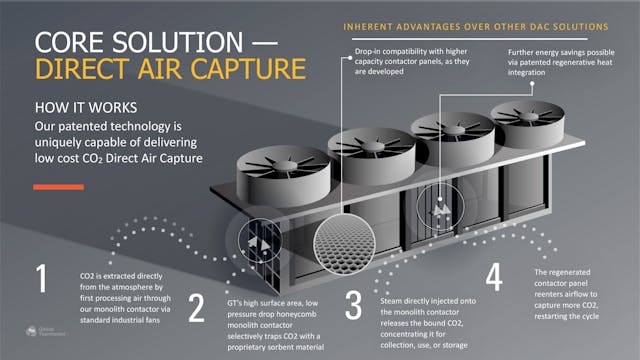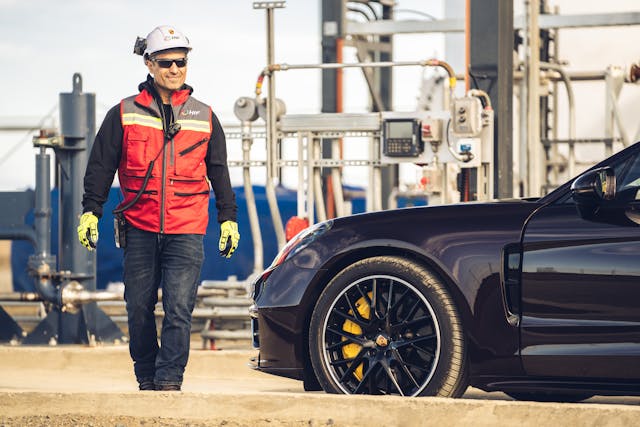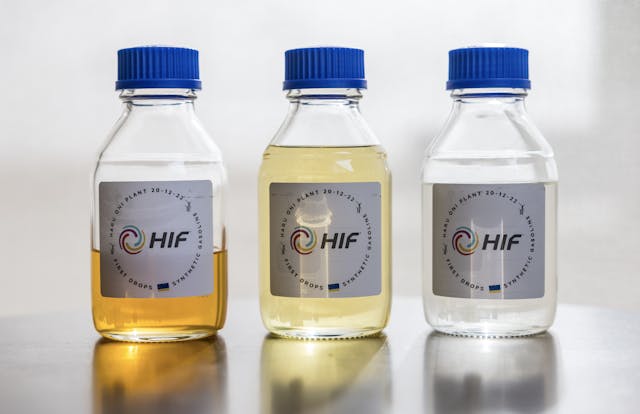Can e-fuels save classic cars?
You’ve probably seen the headlines. Ours, even. Stuff like, “Porsche Creates Magic Gasoline From Wind and Water—Saves Both Internal Combustion and The World.”
It sounds promising but also a bit fantastical, like something out of a supermarket tabloid. So, out of curiosity and a bit of skepticism, we recently went with Porsche to Chile to learn how the stuff is made, what it does, and what it won’t do.
E-fuel sounds exciting but, um … what is it?
In an e-nutshell, it’s a synthetic fuel that is carbon neutral, meaning it’s developed with CO2 that has already been released into the atmosphere using renewable energy. In this case, the renewable is wind. There’s a lot of it here in Chile’s Magallanes Region. As our plane bucked and shuddered with turbulence on its descent, I gazed out at an endless array of whitecaps breaking in the ceaseless gale. On the ground, the wind is both strong and seemingly inexorable, shaping most of the larger flora as they grow into swept and crooked exaggerations.

“It’s not that there’s so much wind, but that it’s so predictable and reliable,” said Marcelo Daller. He manages the facility we’ve come all this way to see, a small plant operated by Highly Innovative Fuels (HIF) Global, which handles the nitty gritty development on this project. Daller’s narration is subtly chopped by the whistling woosh of the facility’s lone wind turbine. He told me there’s no need to build it high, so the blade tips spin just 60 feet from the ground; I caught myself almost ducking as we passed by. HIF estimates 6,000 hours of high-quality wind in the region each year, equating to 70 percent uptime for the turbines.
Those turbines power the entire process, the first step of which is a carbon-dioxide recapture system from Global Thermostats. Think of it as a very, very large air purifier. Fans cycle air through a ceramic honeycomb matrix that—through a variety of processes we’ll just call “chemistry”—separate the CO2 from other molecules. When the final system goes online, HIF expects to scrub 150 kg of CO2 an hour. (At the time of our visit, the system was not yet operational, so for now, the plant sources its renewable “green” carbon dioxide from a brewery.)
At the other end of the facility, 35 percent of the power from that spooky wind turbine is routed to a Siemens electrolyzer that produces 21 kg of green hydrogen per hour through electrolysis. Said hydrogen and CO2 is run through a copper-zinc catalyst to form synthetic methanol that serves as the basis for all the plant’s carbon-neutral hydrocarbon derivatives.

Methanol—familiar to any drag racer—is then put through ExxonMobil’s proprietary methanol-to-gas (MTG) process to transform the alcohol into gasoline. Or kerosene, or diesel. In fact, HIF claims the process can crank the hydrocarbon chains as high as “C12” and crack them as low as “C5,” for the petrochemical nerds in the audience.
Burning the resulting fuel will still release carbon into the atmosphere, just as with conventional fuels. But whereas the carbon in fossil fuels is “new,” having previously been locked in a hydrocarbon molecule underground, that in e-fuels is recycled, having been pulled from the atmosphere.
Wow, that sounds high-tech.
It really isn’t. We’re basically talking about electrolysis, which was first observed in water in 1789. There have been efforts to make synthetic fuels for many decades. Germany, for instance, figured out how to make aviation fuel from coal during World War II. Not even ExxonMobil’s proprietary methanol-to-gas procedure is new. “That is a mature and venerable technology dating back to the 1970s, an outcome of the OPEC oil embargoes and fuel supply pressures,” explained André Boehman, a mechanical engineering professor at the University of Michigan and a leading expert in e-fuels.

“The concept of a drop-in fuel has been around for decades,” agreed John Voelcker, a journalist who, as the founding editor-in-chief of Green Car Reports, has long focused on the green car space. “If you talk to fleet managers—the old and grizzled ones—they will tell you about the ‘Alt Fuel of the Year Problem.’ Because in my lifetime, we have seen ideas involving ethanol, methanol, natural gas, ethanol again in its E85 form, and now ethanol blended in the feedstock at E10, with E15 on its way, and so on.”
Carbon capture is far newer, but still considered old-hat by modern standards. The concept was first posed in 1938, and a large-scale carbon recapture project launched in 1972, according to Columbia University, when the Sharon Ridge oilfield in Texas injected CO2 into the ground. The technology remained somewhat stagnant through the mid-1990s, until Norway’s Sleipner program went live in the North Sea as the first integrated carbon capture and storage project.
The biggest hurdles for alt-fuels of all varieties have been economic rather than technological: conventional fossil fuels are really profitable, alternative fuels are clearly less so. Lacking a business case or regulatory requirements meant there was no reason to pursue them at large scale. “Many alt-fuels come about from a regulatory push,” explained Voelcker. “It’s fairly rare that there is a demand-pull for alt-fuels from actual consumers.”

Concerns about global warming and widespread pressure to reduce use of fossil fuels obviously changes the calculus, which helps explain why Porsche thought the project was worth an investment of $100M (and growing). Like every major automaker, Porsche has lots of electric vehicles in the pipeline—at least 50 percent of its lineup will be battery EVs or plug-in hybrids by 2025, and it’s aiming for that to grow to 80 percent by 2030. But that still leaves a certain number of dino-burners, which I’m willing to speculate hail from the 911 family, and there might simply be too much brand identity and equity on the line to ditch the gas-powered ass-engines entirely.
What would I need to do to my car to use it?
That’s the beautiful part: Nothing. This e-fuel is a true drop-in replacement, provided the mix is correct.
“Most fuels are not specific molecules and more of a mixture of chemicals that fit a certain specification,” explained Stephen McCord, a research fellow at the University of Michigan’s Global CO2 Initiative. In other words, with the right mixture of molecules and proper era-appropriate additives, e-fuels could run anything from an airliner to a Model T to a 917K or a GT3 RS.

Porsche let the assembled journalists pour around 12 gallons of this novel fuel into Panameras, then sent us on our way. Porsche swears it levied no changes unto the Panamera’s ECU or fuel system. I immediately noticed…no differences at all. Not once during our roughly 250-mile tour of Patagonia did the Panamera drop power, cut out, stutter, cough, sniff, or sneeze. My driving partner and I broke conversation every hour or so to remind each other we’re driving on a tank filled with wind and water. “Notice anything? No? Alright. Oh hey! An emu!”
This all sounds fantastic. Where can I buy some?
You can’t, and for the foreseeable future you won’t be able to in any real sense. The demo plant’s current production is capped at around 90 gallons a day, most of which is earmarked for use in Porsche’s Supercup racing series and a rotating fleet of internal test vehicles ranging from a 993 to a 991.2.
A large, full-scale production facility is planned roughly 20 miles south, with 60 windmills providing enough energy to produce 17.4 million gallons of e-fuel for use in South American and European markets. Facilities in Australia for Asian distribution and in Houston, Texas, for North America are also in the works. When all three are online and firing at full capacity, HIF expects a supply of 150,000 barrels of e-fuel a day. That sounds like a lot until you look at production figures for conventional oil—nearly 90 million barrels a day even during the pandemic-cramped years of 2020 and 2021. And even that limited supply won’t be offered directly for sale. Aside from the infinitesimal amount being produced at the Porsche-backed demonstration plant, every drop will be unceremoniously poured into the existing pool of consumer gasoline around the world to bring the general carbon footprint down.

The main limitation to scaling up is financial. Both Porsche and HIF were mum about the real cost of the e-fuel on the consumer side, but they readily admit it would need government subsidies to be competitive. “We can adjust tax politics to make e-fuels cheaper…politics should support investments to make prices more attractive,” Porsche CEO Oliver Blume recently told Reuters.
There are also technical and logistical hurdles. “Arguably the biggest challenge when it comes to scale-up (for all e-fuels, e-chemicals etc.) is hydrogen provision,” said McCord, the University of Michigan researcher. “Simply put, electrolyzers are relatively ‘small’ when compared to the volumes of fuel (therefore H2) we need.” He adds that hydrogen electrolysis is energy intensive; without an affordable renewable form of electricity, producing significant amounts of it for e-fuel would become prohibitively expensive.
Then there’s the fact that e-fuels already have major competition. Comparisons of e-fuel to electric vehicles are largely theoretical at this moment, since neither is close to the scale of fossil fuels, but electric vehicles do enjoy inherent advantages. In particular, using electrons to power vehicles directly is far more efficient than deploying those same electrons to convert CO2 into e-fuels. “Driving solely on e-fuels would require six times more electricity than using BEVs,” stated a 2021 white paper from the International Council on Clean Transportation. In practical terms, that means e-fuels will require vastly more land (and money) for windmills, solar panels, and other forms of renewable energy.

That said, e-fuels have important advantages of their own: They are easier to deliver, given that there’s already a vast network for gasoline, and they could render the billions of cars already on the road more environmentally friendly. Those vehicles, just like when they’re powered by conventional gasoline, would generally be able to travel further and refuel faster than today’s electric vehicles. And if e-fuels present issues at scale, so do EVs. McCord specifically pointed to their reliance on certain metals, like nickel and cobalt, although he noted there has been some progress in this area.
Of course, there’s also politics and perception: Many governments have already weighed in on this discussion with bans on ICE vehicles and incentives for EVs, and a growing segment of the general public sees them as an attractive solution. “The ideal alt-fuel would be one that has regulatory push and consumer pull, and we see that with EVs,” said Voelcker. “Large numbers of people like EVs, they like the idea of fueling at home, they like the idea of instant torque, etc.”
The politics aren’t set in stone—Germany, for instance, has recently lobbied for the European Union’s 2035 ban on the sale carbon-emitting vehicles to make allowances for ICE vehicles powered by e-fuels. Yet for automakers making bets now on where to put their R&D dollars, EVs clearly have an edge.

So, how excited should we be?
We’d still say, “very.” Given all the challenges, it seems unlikely (albeit not impossible) that e-fuels will become a dominant, mainstream source of power for personal transportation. Yet they still have huge promise. McCord noted that they could be a potential solution for sectors where there isn’t yet a viable fossil fuel alternative, such as aviation. And a number of full-size tanker ships can run on e-methanol, eliminating some of our naval reliance on bunker fuel—nasty, sulfurous stuff that has been found to be particularly harmful to people who live along shipping channels.
Most of the independent experts we spoke to describe the relationship between e-fuels, EVs, and other green energy sources not as zero-sum but collaborative—using each where it makes sense in the overall fight to reduce greenhouse gas emissions.
“My personal opinion is that we need all three—battery electric vehicles, biofuels [such as ethanol] and e-fuel to displace petroleum fully,” said Boehman, the University of Michigan engineering professor. “Dropping in things that look like today’s fuels and electrifying where that makes sense (passenger cars, short haul trucking), we can get there.”
Of course, we’re most excited for our old cars. At best, e-fuel might extend the lifeline of the production ICE. At worst, it will freeze it in amber. Taking a thousand-foot view of e-fuels blots out most of the downsides and uncertainty; since there is no noticeable difference in how a vehicle runs on this e-fuel, it means all ICE cars face meaningful and active preservation in an electric future.

***
Check out the Hagerty Media homepage so you don’t miss a single story, or better yet, bookmark it. To get our best stories delivered right to your inbox, subscribe to our newsletters.
Via Hagerty Insider



Meantime China, the largest polluter in the world along with India, is putting approximately 2 coal fired power plants on line every week. Also most of the materials for EVs are sourced from China. And then EV vehicles are priced beyond what the average person can afford. And the electricity to support an EV environment just is not there. Wind and solar is not efficient and very expensive. Not saying we shouldn’t clean up what we do here but it is going to have to be affordable and efficient as well without blowing up our entire economy. Nice to see some trying alternatives rather than follow the rest of the EV crowd.
When it sounds almost too amazing to be true”–and “fantastical” you know that it isn’t true! Let’s take t he manufacture of “free fuel” to the most remote location on Earth–to be sure that no one can afford to access it–and use a wind turbine which never will reach “pay-out” before needing to be overhauled. And, which will need to be scrapped, as a result. AND–for which there is NO repository which can recycle the NOW mountains of the remains. Did we not learn anything from China’s great experiment with electric bicycles–which ended being scrapped in huge mountains of unsalvagable remains? Does no one think of the result of the experiment with these turbines? There’s no good ending–just dreams. Dreams costing Taxpayers trillions–with no favorable results. Yes–“The Emperor Has No Clothes”